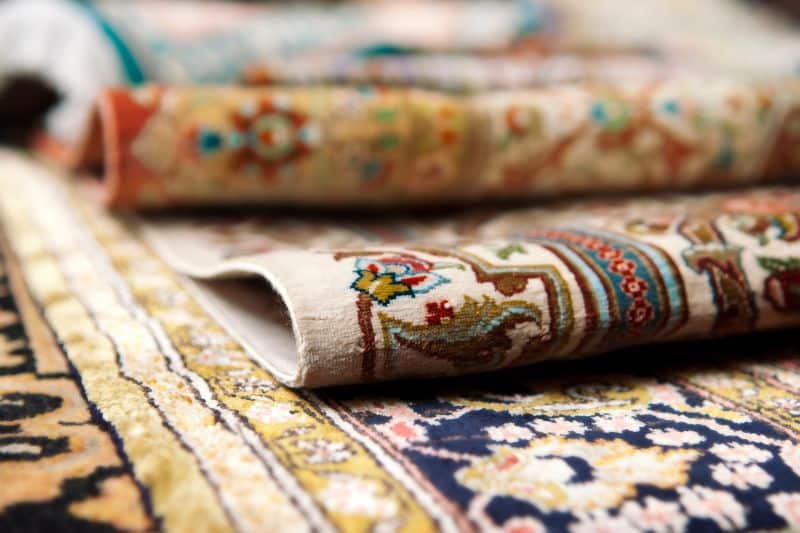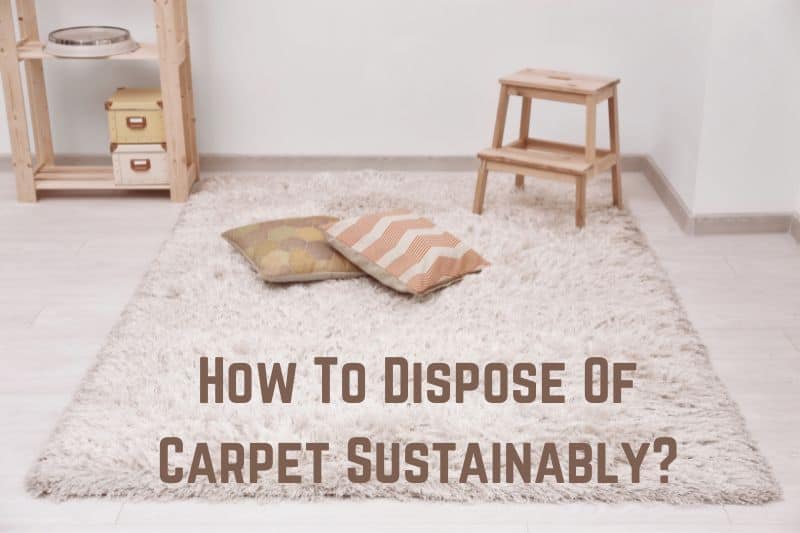Do you dislike your worn-out carpets? Would you prefer wood floors or stained concrete if you renovate your floors? The moment has come to replace your worn-out carpets. However, how should carpets be disposed of properly?
According to the EPA, approximately 500 million kilograms of carpets are disposed of in the US each year. Are you aware that it takes carpets decades to break down? The recycling of carpets is the solution to the waste issue. However, it is more challenging than it would seem.
For a carpet to be effectively recycled, all contaminants must be removed. I will guide you through the complete carpet disposal procedure today and explain why you should not throw your old carpets away.
Ways To Dispose of Carpet Safely
The greatest thing you can do to learn how to dispose of carpets properly is to look up carpet recycling facilities in your neighborhood. It will make it more likely that your previous carpets will be recycled or, at the very least, thrown away in an eco-friendly manner.
If your carpet is eligible for donation, that should be your first action. If you have leftovers from a brand-new carpet instead of an older one over 20 years old, this is a better chance to succeed. However, if it’s in good shape, it is still worth looking into.
If you cannot donate it, your next step should be to find carpet recyclers. I suggest starting with your neighborhood flooring business to see what they offer. Learn more by continuing to read.
1. Nearby Flooring Businesses
Local flooring firms may offer recycling initiatives or collection services at a price to help properly dispose of used carpets. It is crucial to get in touch with them beforehand.
Some businesses might only offer this assistance to paying customers, while others might have limitations on the carpet’s dimensions and condition. Some might even provide a moving service, which is useful.
2. Take-Back Programs at Manufacturers
Several manufacturers have set up carpet take-back schemes. Interface Flooring is one illustration. Returning carpet and recycling it to create fresh flooring materials prevents thousands of pounds of old carpet from ending up in landfills. Unfortunately, many of these schemes are only available to for-profit businesses, but it is still worth checking.
3. Use Old Carpets Again or Donate Them
You can donate your old carpet to someone else or use it for gardens, flooring, animal sheets, or offcuts. On the contrary, since old carpets can be musty, faded, and unattractive, fresh offcuts are far more probable to be reused.
Furthermore, it is extremely unlikely that anyone will agree to buy a worn-out, unkempt carpet from you. You can easily offer your carpet for free through charitable organizations or platforms like Freecycle. You can sell your carpet on eBay, the Instagram Marketplace, and Gumtree in reasonable condition.
4. Consult the Waste Management Company in Your Area
Another choice is to inquire about carpet recycling or disposal with your neighborhood trash management firm. Look up the phone number or address of your garbage management firm online. To find out if they take used carpets for recycling or disposal, you may also contact them by phone or email.
Before leaving, check their instructions or specifications for getting the carpet ready for recycling or disposal. Always double-check with your neighborhood waste management firm to guarantee correct handling and removal before discarding any large or potentially dangerous goods.
5. Work With a Waste Collector
Carpets can be disposed of with other household trash. However, your neighborhood waste collection company might only accept a little old carpet. Instead, you should transport the carpet to a special trash collection site or wait until a day for bulk garbage to be picked up.
We advise contacting your neighborhood rubbish collection agency in advance rather than assuming that the carpet will not be accepted. While some businesses may pick up used carpet for you, others might require you to move the carpet yourself.
Another option is a garbage collection service that can pick up trash from anywhere on the property. You will not have to transport it to a disposal site, which will spare you time and effort.
6. Using Old Carpets as Soundproofing
An answer to noise pollution can be found by repurposing old carpets as sound absorbers. Little bits of carpet can be placed underneath devices like dryers and washers to minimize noise greatly.
In workshops or garages, carpets can also be utilized as muffling mats to lower the decibel level of machinery and power tools. These inventive and useful applications not only lessen waste but also enhance the soundproofing of your house or place of business.

Can Carpets Be Recycled?
Yes, carpet can be recycled. The majority of carpet types can be recycled. Depending on the fiber, the carpet can be disassembled into basic components and turned into a new product. Old carpets can be recycled to make things, including carpet padding, plastic lumber, auto parts, and more.
Although nearly all carpet types can be recycled, the procedure involves placing the carpet next to other curbside recycling. Numerous layers of various materials, such as fibers and plastic, are used to create carpets.
Since they do not break down quickly in landfills, many municipalities will not accept carpets and other household waste. Dropping off a carpet at a specially approved garbage disposal facility is the most effective recycling method.
Padding for carpet can be recycled. The substance that a carpet is padded with. Because it is constructed of a single substance instead of the multiple materials that make up a carpet, padding can be simpler to recycle than carpet. The majority of businesses that recycle carpets are also open to carpet padding.
However, recycling carpet and carpet pads separately is not possible. Padding must be dry in order to be recycled. You can roll it up and dispose of it at a local carpet disposal facility. Make sure the carpet padding does not contain any garbage.
Is Carpet Biodegradable?
Yes, carpet decomposes naturally. However, it breaks down very gradually and decomposes very slowly. It will, therefore, continue to harm the ecosystem in the garbage dump for many years. The type of fibers the carpet is constructed of will determine the duration it will take a carpet to break down.
Nylon is the most widely used carpet material in the US, which takes 40 years to degrade in a landfill. Today’s market offers a variety of environmentally friendly carpet varieties. Carpet tiles are a well-liked alternative created from recycled resources and are easily replaceable in the event of damage.
Broadloom carpet, manufactured from organic materials like cotton, wool, or sisal, is another environmentally friendly carpet. These carpets are costly and frequently stronger and sustainable than synthetic carpets.
Local Regulations on Carpet Disposal
Some regions and municipalities prohibit using dumpsters in domestic or commercial right-of-way areas. We will point you in the direction of the relevant city or local office for additional details and to begin the permitting procedure if they have limitations or licenses required for rental garbage at your residence.
If a permit is necessary for a dumpster to be placed at your residence or business site, it must be set up before the scheduled delivery date. If your home is part of a homeowners’ association, inquire about any restrictions on renting a dumpster there.
Some may limit the types of dumpsters you can use or how many days you can keep one in front of your house.
Environmental Impact of Carpet Disposal
Carpet waste has a similar detrimental effect on the environment as any other plastic. First, the 2,460,000 pounds dumped in landfills decompose very slowly, potentially for hundreds of years, producing emissions and possibly seeping hazardous chemicals into the soil and water.
They are frequently burned, producing potentially harmful contaminants and greenhouse emissions if they do not take up landfill space. Synthetic fibers can easily add to the growing issue of microplastics. These harm all stages of the food chain if they are not disposed of in proper waste streams.
A carpet disposed of in a landfill is equivalent to dumping plastics because neither can be broken down easily, leaving the environment permanently polluted. There are several reasons why you should not discard carpets, including:
- Since the fibers are hard and complicated, it is challenging to disintegrate. Additionally, when carpets are burned in landfills, pollutants are released into the air.
- Rotting or burning carpets can contaminate the air and water, harming both people and animals.
- Carpet disposal results in the release of fossil fuels needed to burn the carpets.
- The fibers may make different goods, including insulation and carpeting. Rags made from used fabrics in excellent condition can be recycled to paper.
- The usage of fossil fuels is reduced when carpet-derived products are recycled to make new materials. Additionally, recycling your carpet rather than throwing it in the trash helps reduce carbon emissions.
- Carpets comprise 1% of waste and 2% of all urban solid garbage volume.
- By recycling carpets, you make room in landfills and produce useful materials for the manufacturing process.
Conclusion
Eco-friendly carpets are transforming the carpet industry by providing a durable and green flooring choice. These carpets use environmentally friendly supplies, reduce waste, and are ethically made. Although they could initially cost more than conventional carpets, they have several long-term cost-saving advantages.
The demand for sustainable carpets will increase as customers become more concerned about the environment, and the carpeting sector will need to change to fulfill this need.






